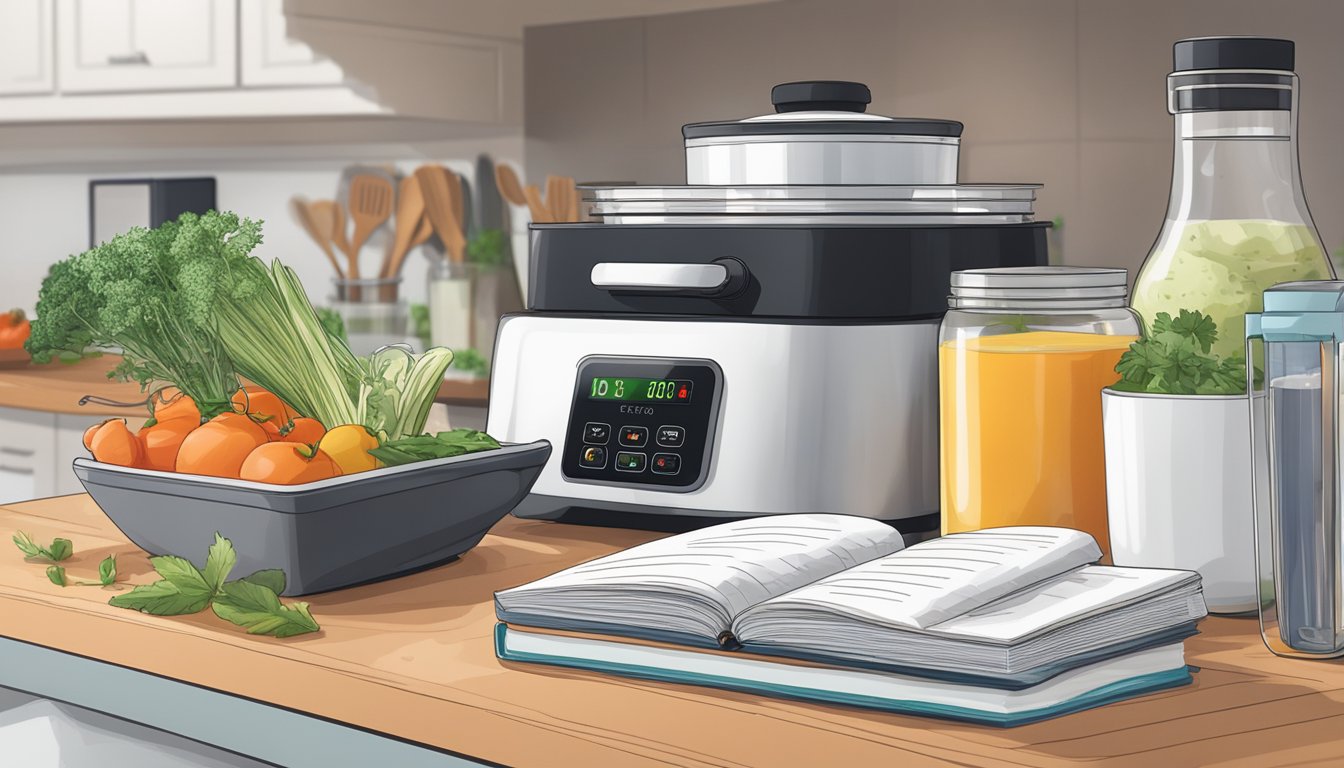Sous vide cooking has revolutionized home kitchens, offering precise temperature control for perfectly cooked meals. This innovative technique can elevate breakfast dishes to new heights of flavor and texture. Using a sous vide machine for breakfast preparation allows for consistent results and hands-off cooking, freeing up time for other morning activities.
The following recipes showcase the versatility of sous vide cooking for breakfast. From classic egg dishes to creative twists on morning favorites, these recipes demonstrate how sous vide can transform ordinary ingredients into extraordinary meals. Each dish highlights the unique benefits of this cooking method, resulting in restaurant-quality breakfasts that can be easily prepared at home.
1) Sous Vide Egg Bites
Sous vide egg bites offer a delicious and convenient breakfast option. These creamy, perfectly cooked morsels have gained popularity since Starbucks introduced them to their menu.
The sous vide method ensures even cooking, resulting in a consistently smooth texture. Eggs are combined with cheese and other ingredients, then cooked in a water bath at a precise temperature.
Common additions include cottage cheese, Gruyere, and Monterey jack for richness. Bacon, vegetables, or herbs can be incorporated for extra flavor. Some recipes suggest a dash of hot sauce for a subtle kick.
For those without a sous vide machine, the oven provides an alternative cooking method. Bake the egg mixture in greased muffin tins at 300°F (150°C) for 30-40 minutes.
Egg bites are not only tasty but also versatile. They can be made ahead and reheated, making them ideal for busy mornings. Leftovers can be frozen and warmed up later, offering a quick and easy breakfast solution.
2) Sous Vide Pancakes

Sous vide pancakes offer a unique twist on a breakfast classic. This cooking method ensures perfectly cooked, fluffy pancakes with consistent texture throughout.
The process involves preparing the batter and sealing it in a vacuum-sealed bag. The bag is then immersed in a precisely controlled water bath, typically set around 180°F (82°C) for 30-40 minutes.
Once cooked, the batter is removed from the bag and portioned onto a hot griddle or pan. A quick sear on each side results in golden-brown pancakes with a tender interior.
Sous vide pancakes can incorporate various ingredients for added flavor. Almond flour provides a nutty taste and gluten-free option, while matcha powder offers a unique green tea flavor and color.
For a savory twist, mushrooms can be incorporated into the batter. This creates a umami-rich pancake perfect for brunch or a hearty breakfast.
Toppings and mix-ins like berries, honey, or cinnamon apples complement the sous vide pancakes beautifully. These additions enhance the flavor profile without compromising the pancakes’ texture.
3) Sous Vide French Toast
Sous vide French toast elevates the classic breakfast dish to new heights of texture and flavor. This method ensures perfectly cooked slices with a custard-like interior and golden exterior.
To prepare, bread slices are dipped in a mixture of eggs, heavy cream, vanilla extract, and cinnamon. The soaked bread is then vacuum-sealed or placed in a ziplock bag using the water displacement method.
The sealed bags are cooked sous vide at 64°C (147°F) for one hour. This precise temperature allows the egg mixture to fully penetrate the bread without overcooking.
After the sous vide process, the French toast is briefly fried in hot butter to achieve a crisp, golden-brown exterior. This step adds a delightful contrast to the creamy interior.
The result is French toast with a consistently perfect texture throughout. Each bite offers a harmonious blend of custardy softness and subtle crispness.
This sous vide method allows for easy preparation of multiple servings simultaneously, making it ideal for family breakfasts or brunch gatherings.
4) Sous Vide Yogurt
Sous vide yogurt offers a precise and convenient method for creating creamy, homemade yogurt. The process begins by heating milk to 108°F (42°C) in a sous vide water bath.
A mixture of ultra-pasteurized milk, sweetened condensed milk, and a small amount of fresh Greek or skyr yogurt as a starter culture is prepared. This combination is then divided into clean jars for incubation.
The filled jars are placed in the sous vide bath and left to ferment for 6-8 hours. During this time, the live cultures multiply and transform the milk into yogurt.
After incubation, the jars are chilled to set the yogurt. The result is a smooth, tangy yogurt with a consistent texture throughout.
Sous vide yogurt can be customized with various flavors and toppings. It serves as an excellent base for parfaits, smoothie bowls, or as a standalone breakfast item.
This method ensures precise temperature control, leading to reliable results and eliminating the need for specialized yogurt-making equipment.
5) Sous Vide Oatmeal

Sous vide oatmeal offers a unique twist on a classic breakfast staple. This method ensures perfectly cooked oats with a creamy texture and consistent flavor throughout.
The precise temperature control of sous vide cooking allows for optimal nutrient retention in the oats. It also prevents overcooking or burning, common issues with traditional stovetop methods.
Steel-cut oats are particularly well-suited for sous vide preparation. The long, slow cooking process at a controlled temperature softens the oats while maintaining their nutty flavor and hearty texture.
Sous vide oatmeal can be prepared overnight, making it a convenient option for busy mornings. The oats are typically cooked at 180°F (82°C) for two hours or longer, depending on desired consistency.
This cooking method allows for easy customization. Fruits, spices, and other flavoring ingredients can be added to the oats before cooking, infusing them with rich flavors.
Popular variations include apple and cinnamon oatmeal, pumpkin spice oatmeal, and oatmeal with fresh berries. The sous vide process ensures that these additional ingredients are cooked to perfection alongside the oats.
Understanding Sous Vide

Sous vide cooking offers precise temperature control and consistent results. This method enhances flavors and textures, making it ideal for breakfast preparations.
What Is Sous Vide Cooking?
Sous vide, French for “under vacuum,” is a cooking technique that uses precise temperature control. Food is sealed in airtight bags and cooked in a water bath at a specific temperature. This method ensures even cooking throughout.
The process involves three main steps: sealing, immersing, and finishing. First, ingredients are vacuum-sealed in plastic bags. Next, these bags are placed in a temperature-controlled water bath. Finally, some foods may be briefly seared or grilled for added texture.
Sous vide machines, like the Anova Precision Cooker, maintain exact temperatures. This precision allows for perfect doneness every time, whether cooking eggs, bacon, or steak for breakfast.
Benefits of Sous Vide for Breakfast
Sous vide cooking offers several advantages for breakfast preparation:
- Consistency: Achieve the same results every time, ensuring perfectly cooked eggs or bacon.
- Time-saving: Prepare ingredients in advance and reheat when needed.
- Nutritional retention: Lower cooking temperatures preserve vitamins and minerals.
- Enhanced flavors: Sealed bags lock in flavors and juices.
Sous vide excels at cooking eggs to specific consistencies. At 149°F (65°C), eggs develop a custard-like texture ideal for dishes like Eggs St. Denise.
Bacon cooked sous vide becomes tender yet crispy when finished in a pan. This method allows for precise control over fat rendering and texture.
Steak and pork cuts maintain their juiciness when cooked sous vide, creating luxurious breakfast options. The technique ensures even doneness from edge to center.
Tips for Perfect Sous Vide Breakfast Dishes

Mastering sous vide breakfast dishes requires attention to temperature control and ingredient selection. These factors significantly impact the texture, flavor, and overall quality of your morning meals.
Temperature and Timing Guidelines
Precise temperature control is crucial for sous vide cooking. For eggs, 63°C (145°F) for 45 minutes yields soft-boiled consistency, while 75°C (167°F) for 13 minutes produces firm yolks. Bacon cooks best at 65°C (149°F) for 12-24 hours, resulting in tender yet crisp texture.
Yogurt fermentation occurs at 43°C (110°F) for 5-8 hours. For French toast, set the temperature to 66°C (151°F) and cook for 1 hour. Adjust times slightly based on personal preference and ingredient thickness.
Always preheat your water bath before adding food. Use a reliable thermometer to verify temperatures. Chill cooked items in an ice bath if not serving immediately.
Choosing the Right Ingredients
Fresh, high-quality ingredients are essential for exceptional sous vide breakfasts. Select organic, free-range eggs for richer flavor and vibrant yolks. Opt for thick-cut bacon to prevent overcooking.
For French toast, choose day-old bread to absorb more custard. Brioche or challah work well. Use full-fat milk or cream for a luxurious texture.
When preparing yogurt, select cultures carefully. Look for probiotic-rich options. Pair sous vide dishes with fresh fruits, herbs, and vegetables for added flavor and nutrition.
Consider using vacuum-sealed bags to prevent water infiltration. Alternatively, use the water displacement method with high-quality zip-top bags.




